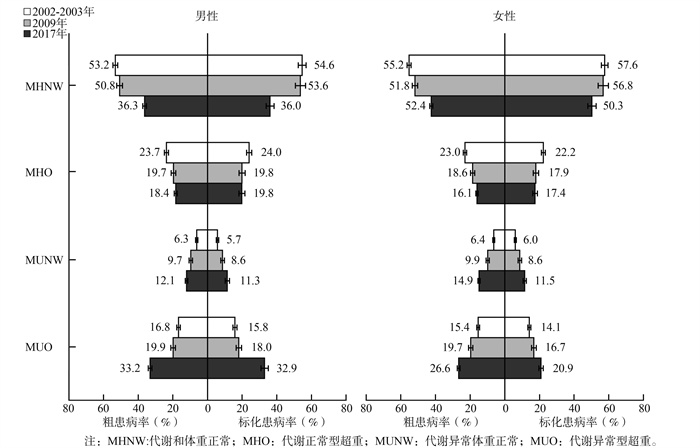Prevalence trend of metabolically unhealthy overweight and impact of educational levels on Chinese adults of Shanghai
-
摘要:
目的 代谢异常型超重(metabolically unhealthy overweight, MUO)对人体健康的危害远甚于代谢正常型超重(metabolically healthy overweight, MHO)。本研究旨在了解上海市成人MUO的患病率水平及变化趋势,探讨人群教育水平的影响。 方法 以上海市2002-2003年(n=12 302)、2009年(n=7 400)和2017年(n=19 023)3次抽样调查中35~74岁居民为研究对象,按其教育水平分为小学及以下组、初高中组和大学及以上组。根据有无超重和MS将人群分为代谢和体重正常(metabolically healthy, normal weight, MHNW)、代谢异常体重正常(metabolically unhealthy normal weight, MUNW)、MHO和MUO四种表型。采用多分类无序Logistic回归分析模型和广义估计方程分析二者关联。 结果 男女性MUO的粗患病率和标化率上升(均有P < 0.001)。各教育程度组MUO标化率均上升,以小学及以下组增幅最大。三次调查均发现女性MUO标化率随教育程度的增加而降低,而2002-2003年和2009年调查发现男性MUO标化率随教育程度的提高而上升(均有P < 0.05)。以MHNW者为参比,调整年龄等因素后,相比于小学及以下组,初高中组男性患MUO风险升高,而初高中组和大学及以上组女性患MUO的风险降低(均有P < 0.05)。 结论 上海市居民MUO患病率上升,且在低教育程度人群中增幅最大。应加大对低教育水平人群尤其是女性群体的健康宣教。 Abstract:Objective Metabolically unhealthy overweight (MUO) is more harmful for human health than metabolically healthy overweight (MHO). This study aims to investigate the prevalence trend of MUO in Chinese adults in Shanghai, and to evaluate the impact of education attainment of the populations. Methods The study was based on three sampling surveys performed in residents aged 35-74 years in Shanghai in 2002-2003 (n=12 302), 2009 (n=7 400) and 2017 (n=19 023). All participants were classified into three groups according their educational levels: primary school or below, middle or high school and college or above, and categorized as four phenotypes based on the presence or absence of overweight and metabolic syndrome (MS): metabolically healthy, normal weight (MHNW), metabolically unhealthy, normal weight (MUNW), MHO and MUO. Multinomial Logistic regression and generalized estimating equation were employed to analyze the association between education level and four phenotypes. Results Both crude and age-standardized prevalence of MUO significantly increased in men and women (P < 0.001). The increase in age-standardized prevalence of MUO was observed in each subgroup of educational level and was the most substantial in the group of primary school or below. The age-standardized prevalence of MUO decreased along with increasing educational attainment in women in the three surveys, whereas the prevalence increased among men in the 2002-2003 and 2009 surveys (all P < 0.05). In the three surveys, after adjusting for age and other confounders, men with middle or high school educational level had a higher risk of MUO than those with educational level of primary school or below, whereas the risk was lower in women with educational levels of middle or high school and college or above (all P < 0.05). Conclusion The prevalence of MUO shows an upward trend in Chinese adults in Shanghai, and increases most among those with low educational levels. Interventions should be addressed in the population, particularly in women with lower educational levels. -
Key words:
- Overweight /
- Prevalence trend /
- Education
-
表 1 三次随机抽样调查对象的基本特征[n(%)]
Table 1. Basic characteristics of participants in the three random sampling surveys [n(%)]
变量 男性 F/χ2值 趋势检验P值 女性 F/χ2值 趋势检验P值 2002-2003年(n=5 023) 2009年(n=3 454) 2017年(n=7 616) 2002-2003年(n=5 023) 2009年(n=3 454) 2017年(n=7 616) 年龄(x±s, 年) 53.6±1.2 54.0±1.2 60.3±1.2 1 482.0 < 0.001 52.1±1.2 54±1.2 59.7±1.2 2 981.0 < 0.001 教育程度 12.1 < 0.001 252.8 < 0.001 小学及以下 1 112(22.3) 619(17.9) 1 539(20.2) 2 996(41.4) 1 066(27.0) 3 261(28.6) 初高中 3 144(62.9) 2 531(73.3) 5 371(70.5) 3 887(53.7) 2 724(69.1) 7 493(65.7) 大学及以上 739(14.8) 303(8.8) 706(9.3) 357(4.9) 154(3.9) 653(5.7) 饮酒 2 034(40.9) 1 862(53.9) 3 889(51.2) 110.6 < 0.001 171(2.3) 198(5.0) 380(3.3) 9.2 0.002 吸烟 3 089(61.6) 2 295(66.5) 5 187(68.2) 55.4 < 0.001 127(1.7) 75(1.9) 128(1.1) 13.5 < 0.001 BMI(x±s, kg/m2) 24.1±1.1 24.1±1.1 25.0±1.1 296.3 < 0.001 24.0±1.2 24.1±1.2 24.5±1.1 95.5 < 0.001 超重 2 034(40.6) 1 365(39.6) 3 922(51.5) 163.4 < 0.001 2 795(38.4) 1 510(38.3) 4 873(42.7) 37.5 < 0.001 MS 1 153(23.0) 1 021(29.6) 3 447(45.3) 689.5 < 0.001 1 583(21.8) 1 167(29.6) 4 732(41.5) 801.7 < 0.001 表 2 教育水平与代谢超重表型的关联
Table 2. The association between educational attainment and metabolic-overweight phenotypes
变量 2002-2003年 2009年 2017年 OR(95%CI)值 OR(95%CI)值 P值a OR(95%CI)值 P值a 男性 小学及以下 MHNW 1.00 1.00 1.00 初高中 MHO 1.06 (0.87~1.29) 1.31 (1.03~1.66) 0.373 1.10 (0.93~1.30) 0.746 MUNW 2.07 (1.41~3.04) 1.52 (1.08~2.12) 0.909 1.65 (1.34~2.02) 0.789 MUO 1.35 (1.07~1.69) 1.69 (1.31~2.18) 0.126 1.28 (1.11~1.47) 0.715 大学及以上 MHO 1.24 (0.95~1.63) 1.10 (0.75~1.61) 0.711 1.04 (0.80~1.35) 0.083 MUNW 2.18 (1.35~3.51) 1.81 (1.13~2.90) 0.476 1.51 (1.10~2.06) 0.649 MUO 1.40 (1.03~1.91) 1.54 (1.05~2.25) 0.416 1.11 (0.88~1.38) 0.845 女性 小学及以下 MHNW 1.00 1.00 1.00 初高中 MHO 1.04 (0.90~1.20) 0.85 (0.69~1.05) 0.456 0.80 (0.71~0.91) 0.154 MUNW 0.78 (0.61~0.99) 0.79 (0.61~1.02) 0.064 0.92 (0.80~1.04) 0.005 MUO 0.71 (0.60~0.84) 0.79 (0.64~0.96) 0.659 0.70 (0.63~0.77) 0.178 大学及以上 MHO 0.88 (0.63~1.21) 0.70 (0.44~1.11) 0.561 0.50 (0.38~0.65) 0.893 MUNW 0.92 (0.56~1.51) 0.43 (0.22~0.84) 0.893 0.56 (0.42~0.74) 0.134 MUO 0.51 (0.33~0.78) 0.42 (0.25~0.70) 0.234 0.43 (0.34~0.54) 0.294 注:a交互作用检验。 -
[1] Lassale C, Tzoulaki I, Moons K, et al. Separate and combined associations of obesity and metabolic health with coronary heart disease: a pan-European case-cohort analysis[J]. Eur Heart J, 2018, 39(5): 397-406. DOI: 10.1093/eurheartj/ehx448. [2] Wang BY, Zhang M, Wang S, et al. Dynamic status of metabolically healthy overweight/obesity and metabolically unhealthy and normal weight and the risk of type 2 diabetes mellitus: A cohort study of a rural adult Chinese population[J]. Obes Res Clin Pract, 2018, 12(1): 61-71. DOI: 10.1016/j.orcp.2017.10.005. [3] Blanquet M, Legrand A, Pélissier A, et al. Socio-economics status and metabolic syndrome: a meta-analysis[J]. Diabetes Metab Syndr, 2019, 13(3): 1805-1812. DOI: 10.1016/j.dsx.2019.04.003. [4] Jaacks LM, Vandevijvere S, Pan A, et al. The obesity transition: stages of the global epidemic[J]. Lancet Diabetes Endocrinol, 2019, 7(3): 231-240. DOI: 10.1016/S2213-8587(19)30026-9. [5] 中国心血管健康与疾病报告编写组. 中国心血管健康与疾病报告2019概要[J]. 中国循环杂志, 2020, 35(9): 833-854. DOI: 10.3969/j.issn.1000-3614.20.09.001.The Writing Committee of the Report on Cardiovascular Health and Diseases in China. Report on cardiovascular health and diseases in China 2019: An updated summary[J]. Chin Circul J, 2020, 35(9): 833-854. DOI: 10.3969/j.issn.1000-3614.20.09.001. [6] Li YY, Jiang HK, Cheng MN, et al. Performance and costs of multiple screening strategies for type 2 diabetes: two population-based studies in Shanghai, China[J]. BMJ Open Diabetes Res Care, 2020, 8(1): e001569. DOI: 10.1136/bmjdrc-2020-001569. [7] World Health Organization, Regional Office for the Western Pacific. The Asia-Pacific perspective: redefining obesity and its treatment[M]. Sydney: Health Communications Australia, 2000. [8] Grundy SM, Cleeman JI, Daniels SR, et al. Diagnosis and management of the metabolic syndrome: an American Heart Association/National Heart, Lung, and Blood Institute Scientific Statement[J]. Circulation, 2005, 112(17): 2735-2752. DOI: 10.1161/CIRCULATIONAHA.105.169404. [9] Doll R, Payne P, Waterhouse J. Cancer incidence in five continents, Vol. I[M]. Geneva: Union Internationale Contre le Cancer, 1966. DOI: 10.1007/978-3-642-85849-9 [10] Segi M. Cancer mortality for selected sites in 24 countries (1950-57)[M]. Sendai: Department of Public Health, Tohoku University of Medicine, 1960. [11] Homma Y, Saewyc E, Zumbo BD. Is it getting better? An analytical method to test trends in health disparities, with tobacco use among sexual minority vs. heterosexual youth as an example[J]. Int J Equity Health, 2016, 15: 79. DOI: 10.1186/s12939-016-0371-3. [12] Xu H, Li X, Adams H, et al. Etiology of Metabolic Syndrome and Dietary Intervention[J]. Int J Mol Sci, 2018, 20(1): 128. DOI: 10.3390/ijms20010128. [13] Moore JX, Chaudhary N, Akinyemiju T. Metabolic syndrome prevalence by race/ethnicity and sex in the United States, National Health and Nutrition Examination Survey, 1988-2012[J]. Prev Chronic Dis, 2017, 14: E24. DOI: 10.5888/pcd14.160287. [14] Jiwani SS, Carrillo-Larco RM, Hernández-Vásquez A, et al. The shift of obesity burden by socioeconomic status between 1998 and 2017 in Latin America and the Caribbean: a cross-sectional series study[J]. Lancet Glob Health, 2019, 7(12): e1644-e1654. DOI: 10.1016/S2214-109X(19)30421-8. [15] Wu H, Bragg F, Yang L, et al. Sex differences in the association between socioeconomic status and diabetes prevalence and incidence in China: cross-sectional and prospective studies of 0.5 million adults[J]. Diabetologia, 2019, 62(8): 1420-1429. DOI: 10.1007/s00125-019-4896-z. [16] Chen ML, Wu YK, Narimatsu H, et al. Socioeconomic status and physical activity in Chinese adults: a report from a community-based survey in Jiaxing, China[J]. PloS one, 2015, 10(7): e0132918. -





 下载:
下载:


